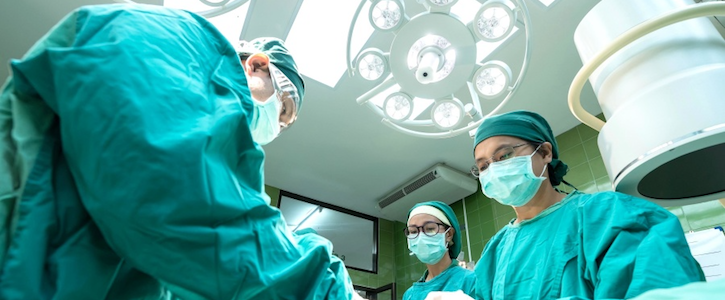Reducing Postoperative Readmissions: There's an App for That
How mHealth is striving to fight surgical complications.

With readmission surveys indicating that as many as 1 in 5 colorectal surgery patients return to the hospital because of complications, a surgeon who considers many of those issues preventable has developed a mobile health (mHealth) application to help patients avoid them.
Heather Yeo, MD, the Nanette Laitman Clinical Scholar in Healthcare Policy and Research/Clinical Evaluation at Weill Cornell Medicine and a surgical oncologist at NewYork-Presbyterian/Weill Cornell Medical Center, worked with Cornell Tech to develop a smartphone app that prompts patients to adhere to optimal postoperative care. The mHealth app queries their daily status, including through photo documentation of wound healing, and alerts both the patient and their clinician to the first signs of a worsening course.
“Readmission is common after [gastrointestinal] cancer surgery,” Yeo told Healthcare Analytics News™, “so we are trying to see if our app can help by picking up on problems earlier, trying to avoid readmission and help patients motivate to be more active earlier."
>> Read: mHealth Is Powered by Potential but Dogged by Dubious Studies
Yeo had gained particular appreciation of the potential of an app to bring patient and clinician closer for better outcomes from having technology enhance her own communication between generations and across geographical distance.
“My grandmother lived to 102, and she and I were very close. Over the last 15 years or so of her life, she learned how to send email and use the internet. After I moved away for college and medical school, it was one of the ways we communicated. In fact, she took her first selfie at her 100th birthday,” Yeo recalled.
“I have a number of older adult patients and saw apps as a way to connect to them and help track them as they recover.” she said. “It’s not practical to call them every day, and even then that doesn’t give us all the info we need."
Building an App Acceptable to Patients, Useful to Clinicians
To identify the types of patient information that could be used to enhance postoperative care and improve outcomes, Yeo and colleagues searched the literature and reached out to a range of stakeholders in postoperative recovery, including patients, nurses, enterostomal therapy nurses, surgeons, and their office staff.
The app was subsequently developed with 5 principle components:
- Surveys with general questions and those specific to the type of surgery
- Alerts to both patient and clinicians when survey responses are concerning, and reminders to drink water
- Patient-provided photographs of the surgical closure, ostomy if present, and urine
- Step-counting data from a fitness wrist monitor
- Score from the photoaffective meter (PAM), a validated, single-item visual measure of affect based on the Positive and Negative Affect Schedule (PANAS)
In the published report of the pilot study of the app in 31 patients, Yeo and colleagues explained the approach taken in developing the survey and alerts.
“Questions were designed to identify nascent common causes of preventable readmission such as dehydration and poor oral intake. Answer options utilized clear numeric cutoffs whenever possible to minimize subjectivity in responses,” they wrote.
The alerts correspond to the most common causes of readmission, including ileus/obstruction, dehydration, surgical site infection, and excessive ostomy output.
“To minimize excessive alerts, warnings were designed to be triggered only by serious conditions likely to require intervention. Such conditions included vomiting, fever, and excessive ostomy output,” Yeo and colleagues noted.
To produce a mobile app that was not daunting to patients and could convey useful, timely information from them to their clinicians, Yeo collaborated with Deborah Estrin, PhD, professor of healthcare policy and research at Weill Cornell Medicine.
“Dr. Estrin has been active in health tech and mHealth for decades,” Yeo said. “She was working with the CTSC [Clinical and Translational Science Center] at Weill Cornell, and we connected through them/ I reached out to them to find out if there was interest, and we have been collaborating since."
Estrin told HCA that she shared Yeo’s enthusiasm for the project. “I was delighted to advise Yeo on use of the latest open frameworks and best practices for mobile health application development,” she said.
“With the increasing attention to chronic disease management and remote monitoring of recently discharged patients, as well as those aging in place, mobile health is being adopted broadly,” Estrin commented.
Testing the Technology
In the pilot study with 31 patients, including 6 who received an ostomy as part of their surgery, 83.9% completed an app-related task at least 70% of the time, and 89% reported that they found the app easy to use.
There was an average of 1.1 patient-generated alerts, with the single patient requiring readmission having generated 7 alerts. The highest reported data were from the step-counting monitor and the single-item PAM. The lowest provision of data was through photo documentation (completed by 51.4%), as many patients encountered difficulty uploading the photographs.
“Overall, patients were interested and participated. Patients are interested and excited, and they want to learn,” Yeo said.
A larger, randomized control trial of the app is currently underway, but Yeo is already anticipating modifications and improvements in the app and its interface with patient and clinicians.
“We want to continue to improve it and evolve it with feedback from patients,” Yeo said. “But we do believe that as we become more and more able to use apps in patient care, this will revolutionize healthcare.”
Get the best insights in healthcare analytics directly to your inbox.
Related
mHealth Apps Show Promise for Mental Health
Podcast: Adoption of Healthcare Tech in the Age of COVID-19 with Dr Kaveh Safavi
June 22nd 2021Kaveh Safavi, MD, JD, global health lead of Accenture Health, discusses how the pandemic influenced the speed at which healthcare organizations adopted new technologies and how this adoption is impacting patient care.